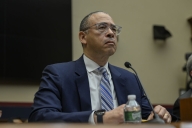You have /5 articles left.
Sign up for a free account or log in.
The impact of the coronavirus epidemic on higher education has been swift. The outbreak has already upended conference schedules and athletic events, and institutions have begun to cancel classes and move them online. It is forcing colleges to consider large-scale preventative measures to keep students and faculty healthy, as well as to create plans for when infections do materialize on their campus. Institutions are also grappling with the impact on exchange programs and international students. Colleges and universities will continue to have to deal with these and a series of other deep and complex challenges in the near term.
The real danger, however, may be lurking in the long-term fallout from the epidemic. Years of budget cuts and the failure to address basic student needs make higher education particularly vulnerable and potentially unequipped to deal with a crisis like this. It’s crucial that the U.S. Congress and the Department of Education act swiftly and aggressively and provide states and institutions with much-needed support before it’s too late.
The first, and clearest, long-term impact of the COVID-19 outbreak is likely to be on state budgets. Whether coronavirus brings about a long-term, deep recession domestically remains unclear, but it is sure to have an effect on economic growth. And slower growth portends terrible things for state colleges and universities, especially community colleges. Nearly a decade into the economic recovery, per-student state funding is still below pre-recession levels. In fact, in states like Arizona, per-student funding has been cut more than 40 percent since the Great Recession. If something caused a prolonged slowdown, it would have the usual devastating consequences on public higher education budgets -- yet today, on top of that, many states and systems have fewer resources to start with than they did a decade or so ago. A global epidemic, coupled with a continued decline in international enrollments, could throw some university systems’ entire business models into chaos.
Even absent a recession, colleges and universities will probably face cuts in the next year or two as state money flows away from higher education and toward public health. Like higher education, state public health systems are stretched and, to put it lightly, states are not often in the business of budgeting for global pandemics. The Centers for Disease Control and Prevention’s budget for state and local emergency preparedness has been significantly slashed, leading states like New York to appropriate tens of millions of dollars to equip health-care workers and provide needed supplies to patients.
As states direct their resources toward much-needed public health services and away from higher education, it’s incumbent on Congress to act in the short term by providing fiscal support -- some of which can go toward addressing an outbreak, and some of which can go toward backstopping any lost revenue that higher education institutions could have not possibly prepared for. In the long term, we need a robust federal-state partnership that helps states consistently refund public colleges and universities, enabling those institutions to weather recessions and other economic shocks. One could imagine a new partnership that automatically kicks in new funding to state higher education systems when something unexpected like coronavirus threatens to strain budgets.
Moreover, we’re also less prepared today to help students navigate an outbreak. Students may face steep medical bills, upwards of several thousand dollars, that they could have neither expected nor budgeted for, leading them to drop out or take on medical or student debt to cover those expenses. While some states, including New York, have begun to waive fees associated with testing for the coronavirus, it is far from a guarantee that other states or the federal government will do the same. For students, particularly those with high-deductible insurance plans, an unlucky diagnosis could be the difference between staying in college and abandoning their educational dreams.
Finally, the safety net for financially needy students remains threadbare. If campuses close for any amount of time, those without access to campus food pantries and services may not be able to take advantage of programs like SNAP, the new rules of which have already made it more difficult for part-time students to afford food. Similarly, for the significant number of students facing housing insecurity, any disruption to campus housing, or budget cuts that prevent colleges from addressing affordable housing, could leave many with no place to go. And the 3.8 million students with children of their own could be forced to find new childcare arrangements other than at on-campus facilities at a time of high daycare costs.
These issues -- continued underfunding and the lack of a basic safety net for students -- must be dealt with regardless of the current unease around the coronavirus. But this moment is bringing into sharp relief the fact that Congress and states have not prepared us for any kind of financial shock to colleges and universities, states or students. Without an injection of support from Washington, the current situation threatens to go from a short-term logistical nightmare to a disastrous long-term drag on higher education.








